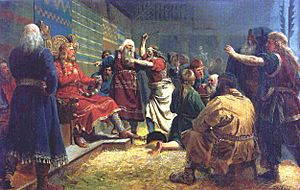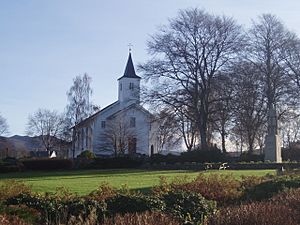Haakon the Good facts for kids
Quick facts for kids Haakon the Good |
|
|---|---|

Håkon den gode, 1860. Oil on canvas by Peter Nicolai Arbo.
|
|
| King of Norway | |
| Reign | 934–961 |
| Predecessor | Eric Bloodaxe |
| Successor | Harald Greycloak |
| Born | c. 920 Håkonshella, Hordaland, Norway |
| Died | 961 Håkonshella, Hordaland (fatally wounded in the Battle of Fitjar) |
| Burial | Seim, Hordaland, Norway |
| Issue | Thora |
| House | Fairhair dynasty |
| Father | Harald Fairhair |
| Mother | Thora Mosterstong |
| Religion | Norse paganism, Chalcedonian Christianity |
Haakon Haraldsson (born around 920, died 961) was a famous king of Norway. He ruled from 934 to 961. People knew him as Haakon the Good or Haakon Adalsteinfostre. He tried to bring Christianity to Norway.
Contents
Early Life of King Haakon
Haakon was the youngest son of King Harald Fairhair and Thora Mosterstang. He was born in Håkonshella, Hordaland, Norway. To keep him safe, his father sent him to England.
Haakon was raised by King Athelstan of England. This was part of an agreement between the two kings. Because of this, Haakon was called Adalsteinfostre, meaning "Athelstan's foster-son".
At the English court, Haakon learned about the Christian religion. When his father died, King Athelstan helped Haakon. He gave him ships and men to go back to Norway. Haakon wanted to take the throne from his half-brother, Eric Bloodaxe.
Haakon's Reign as King
When Haakon arrived in Norway, he gained support from the landowners. He promised to stop the taxes his father had placed on their land. Eric Bloodaxe soon lost all his supporters.
Eric and his family had to flee Norway. He went to the Orkney Islands and later to the Kingdom of Jorvik. Eric Bloodaxe died in 954.
Battles Against Eric's Sons
Haakon had to fight many battles against Eric Bloodaxe's sons. In 953, he won a fierce battle at Avaldsnes. Eric's son Guttorm died in this fight.
One of Haakon's most famous wins was the Battle of Rastarkalv in 955. He tricked Eric's sons into thinking his army was much larger. He placed ten flags far apart to make his forces look bigger.
Eric's sons believed they were outnumbered and fled. Haakon's army then defeated them. Eric's sons tried again in 957, with help from the Danish king, Gorm the Old. But Haakon's strong army defeated them once more.
Haakon is known for starting the leiðangr system in Norway. This was a way to call up a navy when needed. It was similar to a system used by King Athelstan in England.
Succession and Death
In 961, three of Eric Bloodaxe's sons secretly landed in Hordaland. They surprised King Haakon at his home in Fitjar. Haakon was badly wounded in the Battle of Fitjar.
An arrow pierced his arm, and he died later from his injuries. He was buried in a burial mound called Håkonshaugen in Seim. After his death, his poet, Eyvindr Skáldaspillir, wrote a poem about him. The poem, Hákonarmál, tells of the king's fall in battle and his welcome into Valhalla.
After Haakon's death, Harald Greycloak, Eric Bloodaxe's oldest son, became King Harald II. However, he had little power outside of western Norway. The country then faced many years of war.
See also
 In Spanish: Haakon I de Noruega para niños
In Spanish: Haakon I de Noruega para niños
- Hákonarmál


